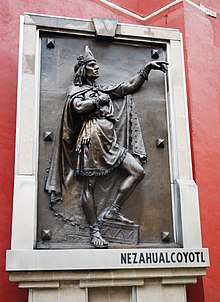
Back Nezahualcoyotl Afrikaans Nezahualcóyotl AST Nezahualcoyotl BAR Несауалкойотъл Bulgarian Nezahualcóyotl Catalan Nezahualcóyotl (Acolhua) Czech Nezahualcóyotl (König) German Nezahualcóyotl Esperanto Nezahualcóyotl Spanish Nezahualcóyotl Basque
| Nezahualcoyotl | |
|---|---|
 Bronze casting done of Nezahualcoyotl by Jesús Fructuoso Contreras in the Garden of the Triple Alliance located in the historic center of Mexico City. | |
| Tlatoani of Texcoco | |
| Reign | 1429–1472 |
| Predecessor | Ixtlilxochitl I |
| Successor | Nezahualpilli |
| Born | April 28, 1402 Texcoco |
| Died | June 4, 1472 (aged 70) Texcoco |
| Spouse | Azcalxochitzin |
| Issue | Nezahualpilli |
| Father | Ixtlilxochitl I |
| Mother | Matlalcihuatzin |
Nezahualcoyotl (Classical Nahuatl: Nezahualcoyōtl [nesawalˈkojoːtɬ], ⓘ), "Fasting Coyote"[1] (April 28, 1402 – June 4, 1472) was a scholar, philosopher (tlamatini), warrior, architect, poet and ruler (tlatoani) of the city-state of Texcoco in pre-Columbian era Mexico. Unlike other high-profile Mexican figures from the century preceding the Spanish conquest of the Aztec Empire, Nezahualcoyotl was not fully Mexica; his father's people were the Acolhua, another Nahuan people settled in the eastern part of the Valley of Mexico, on the coast of Lake Texcoco. His mother, however, was the sister of Chimalpopoca, the Mexica king of Tenochtitlan.
King Nezahualcoyotl is best remembered for his poetry; for his Hamlet-like biography as a dethroned prince with a victorious return, leading to the fall of Azcapotzalco and the rise of the Aztec Triple Alliance; and for leading important infrastructure projects, both in Texcoco and Tenochtitlan;[2] and exceptional intelligence, enabling -- on the last day of his life -- the most devastating of his mind-games against Montezuma. According to accounts by his descendants and biographers, Fernando de Alva Cortés Ixtlilxóchitl and Juan Bautista Pomar, he had an experience of an "Unknown, Unknowable Lord of All" (which aligns, intriguingly, with "I Am Who I Am," whom Moses had encountered in the Eastern Hemisphere). Nezahualcoyotl built an entirely empty temple to this God, in which no blood sacrifices of any kind were permitted, while allowing the standard sacrifices to continue elsewhere.[3]
- ^ "Nezahualcoyotl. | Nahuatl Dictionary". nahuatl.wired-humanities.org. Retrieved 2025-01-31.
- ^ Nezahualcoyotl: Texcoco’s Warrior Poet, Philosopher and King, retrieved 2023-03-26
- ^ Prescott, William H. (1904). History of the Conquest of Mexico. Paris: J. B. Lippincott Company. p. 208.